I remember the immense hype around the Nikon Df just before its release in 2013 – teaser campaigns; leaked specs, mystery mock-ups. Then came a tsunami of derision and disappointment when the Df hit the market. I was one of the disappointed ones; when I saw its bloated form in a camera-shop window I did not even bother to go inside for a closer look.
Here’s how chunky it looks compared to some of my Nikon film cameras:
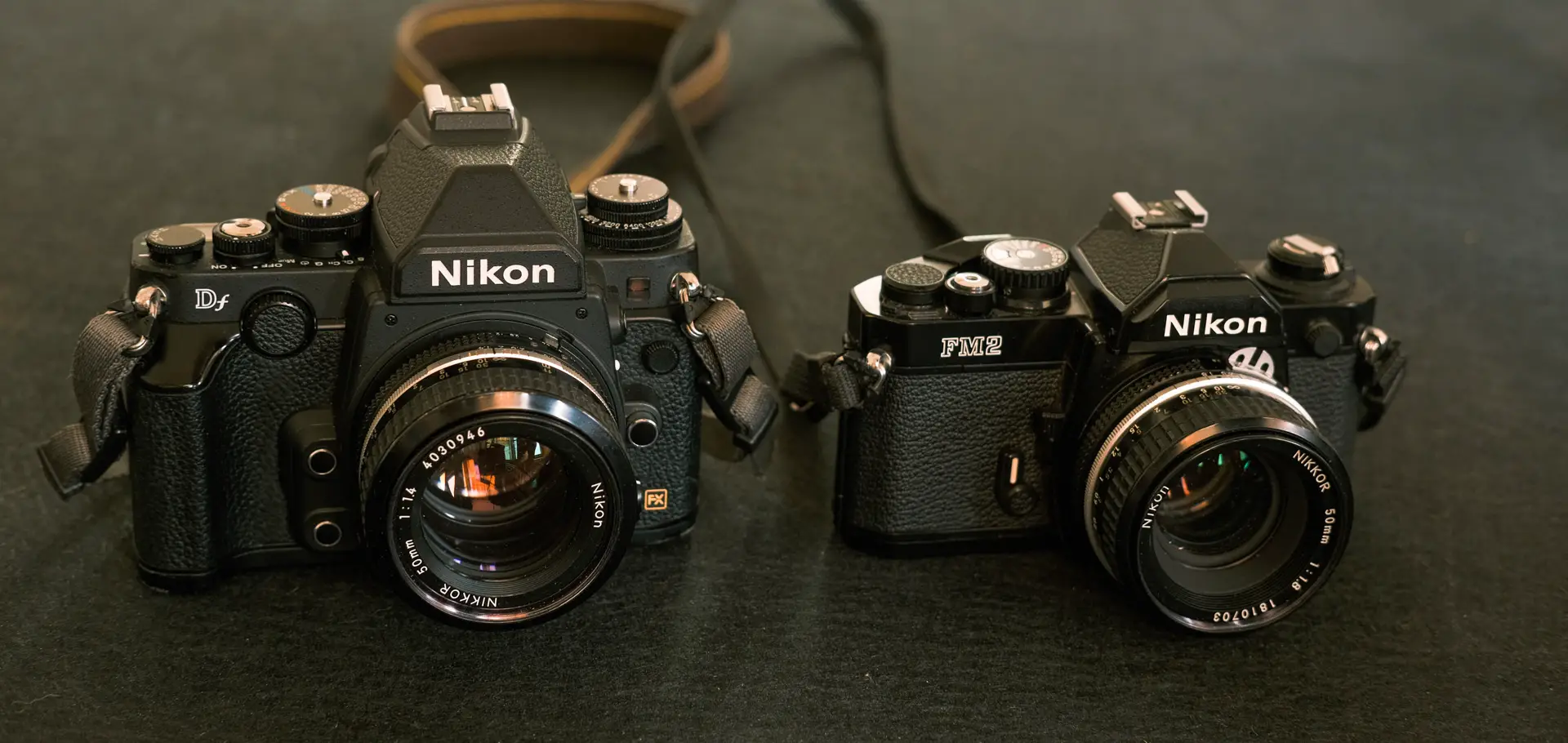
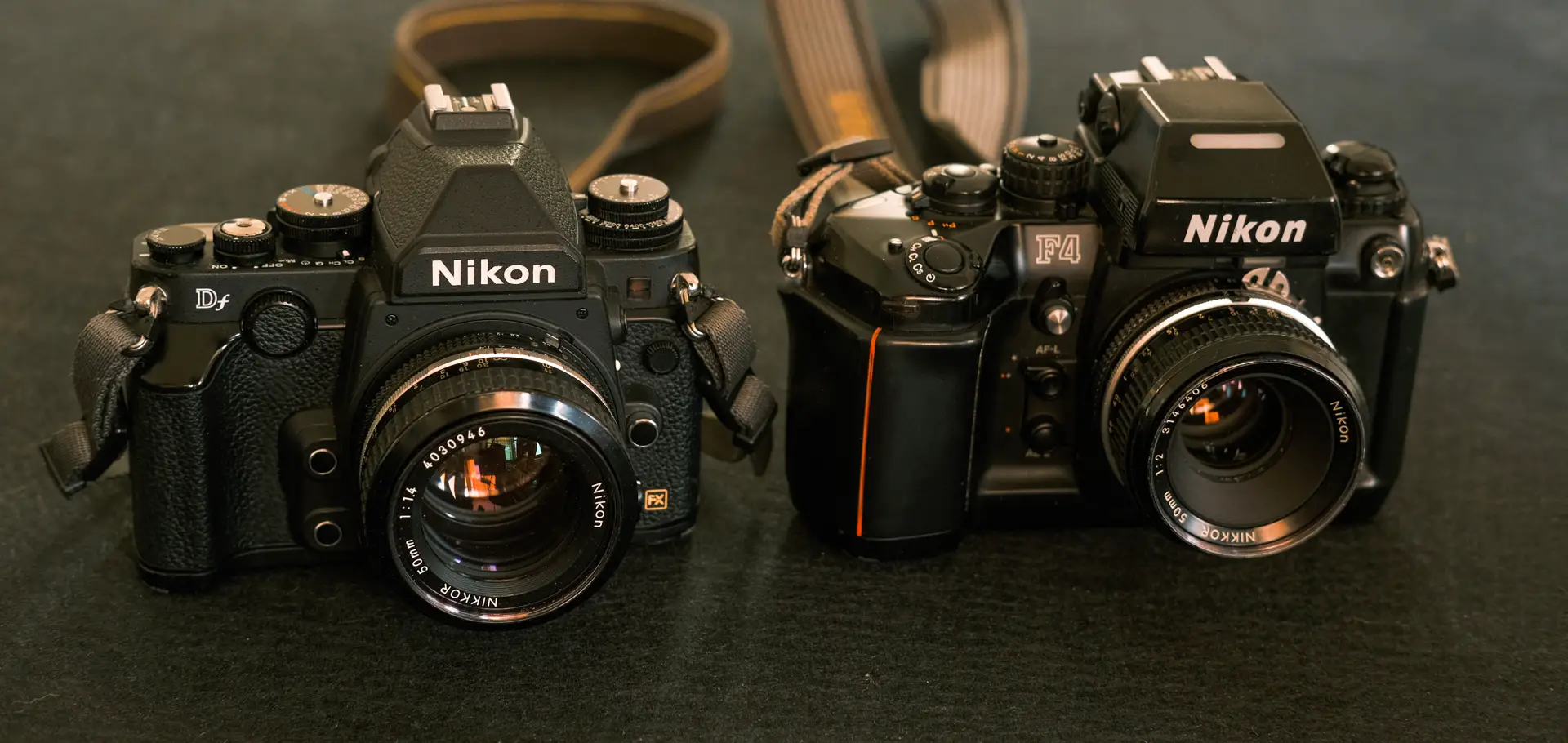
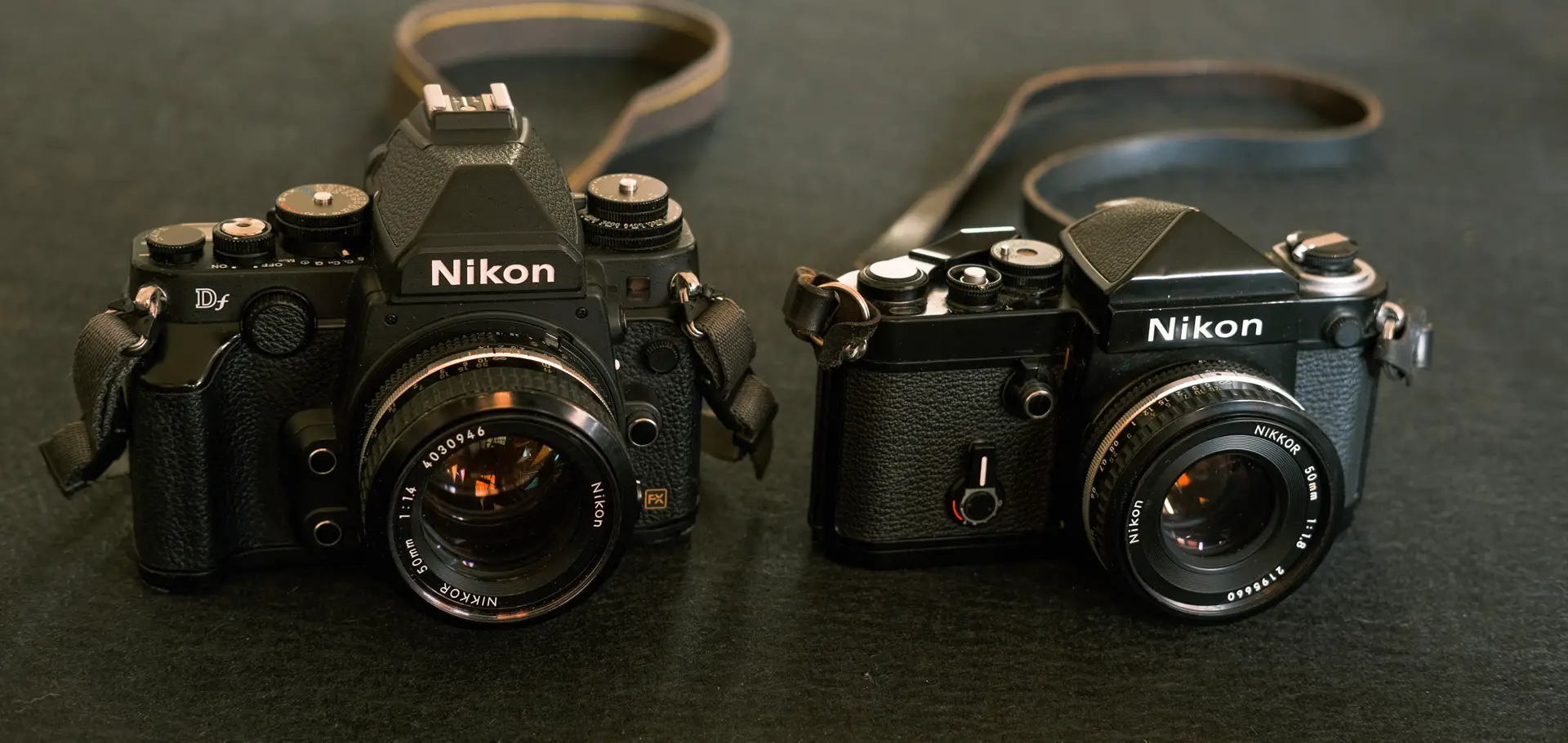
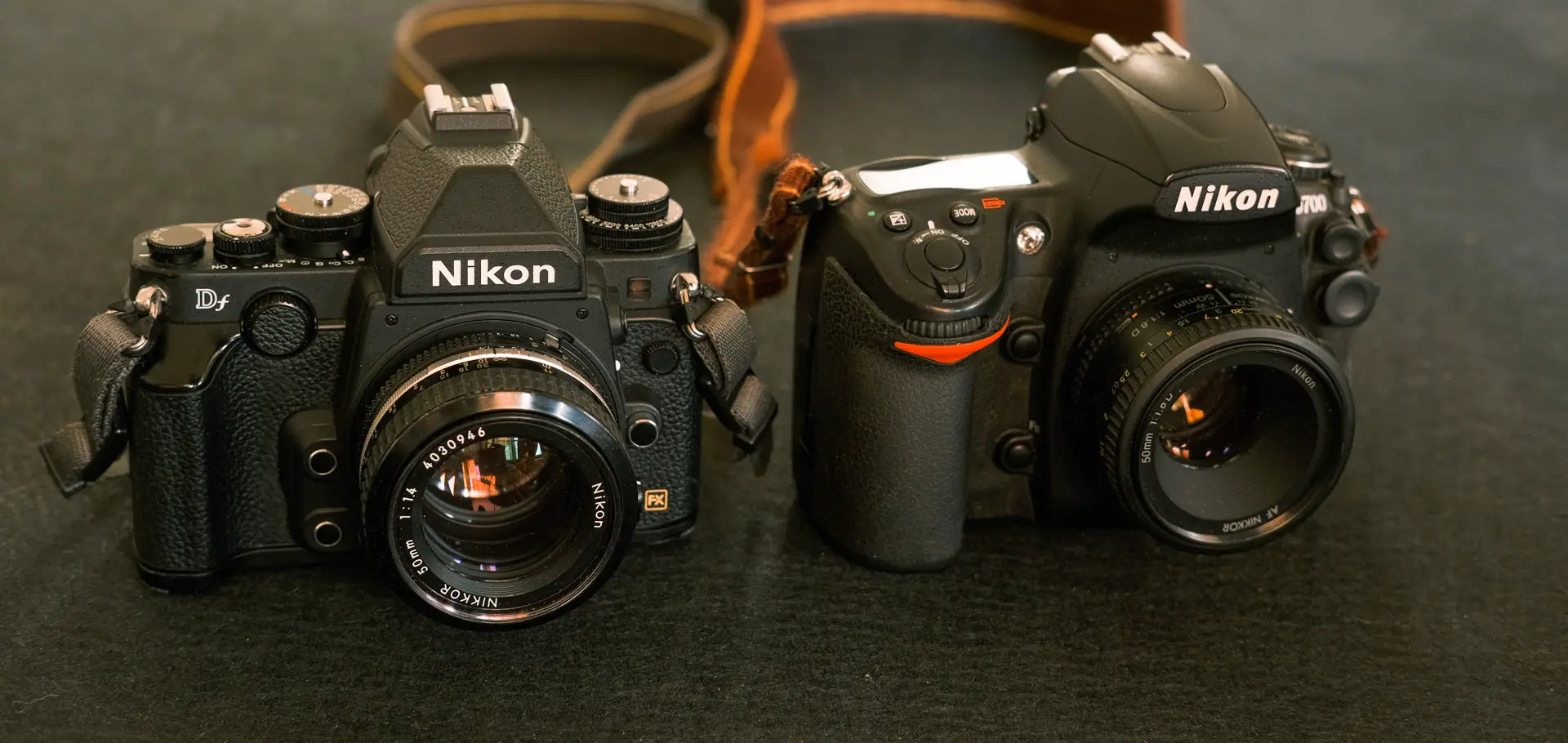
So why would I buy one in 2022?
Let me explain. Firstly I have a developing obsession with the relationship between film and digital, and I wanted a full-frame dig to work with alongside my 35mm film cameras. I wanted something that was as close I could get to my Nikon SLR film bodies – and that would have to be a Nikon DSLR right?
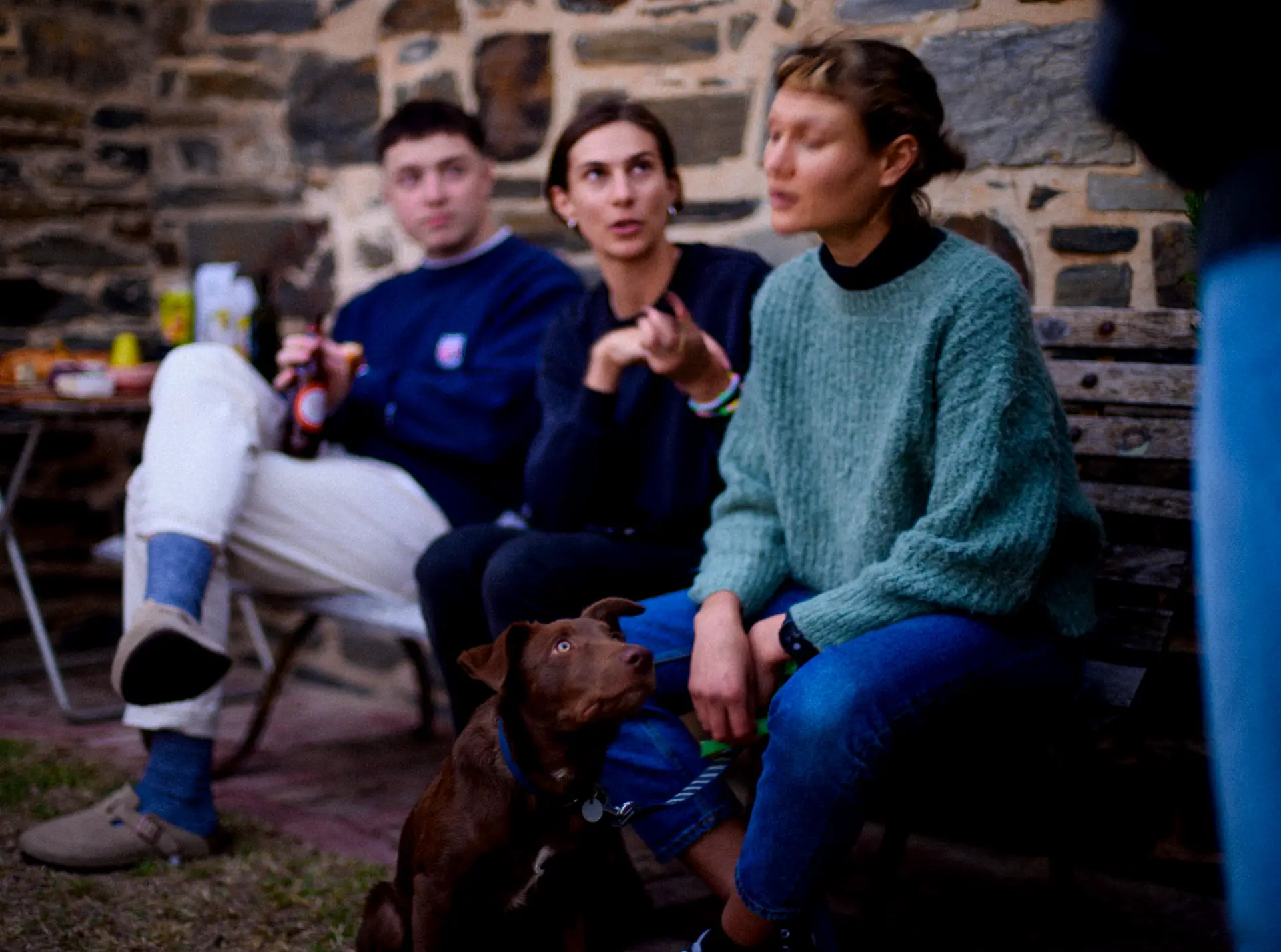
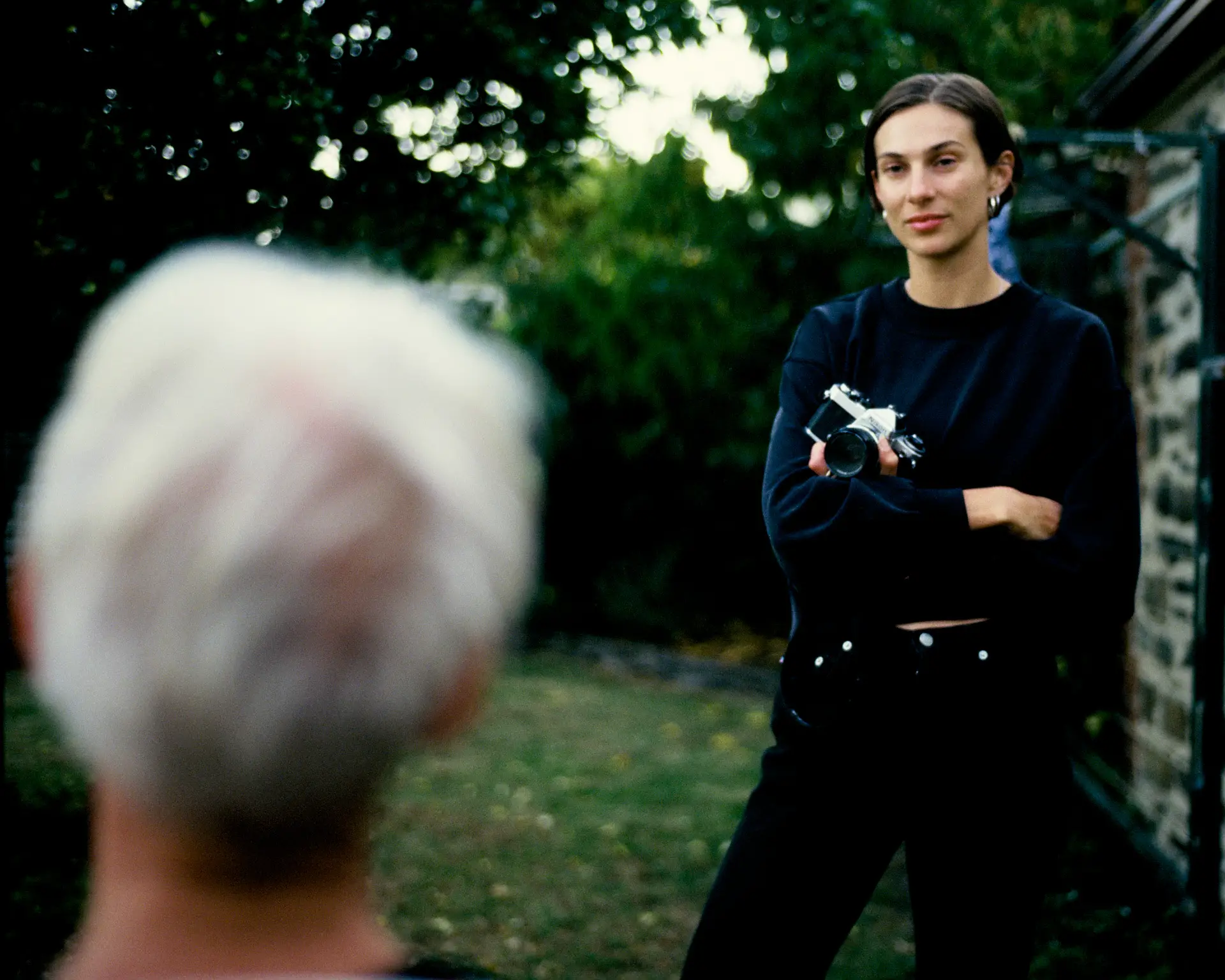
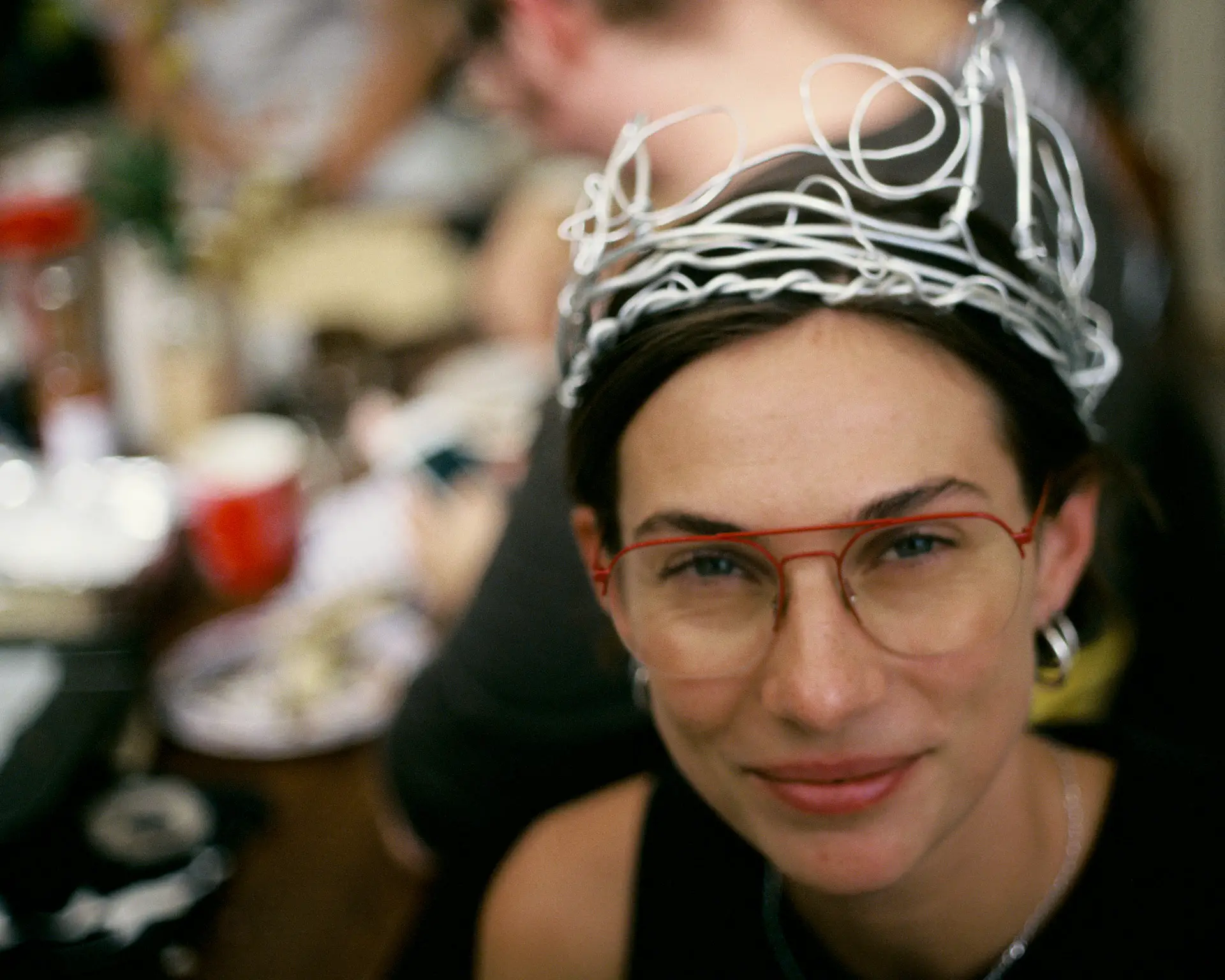
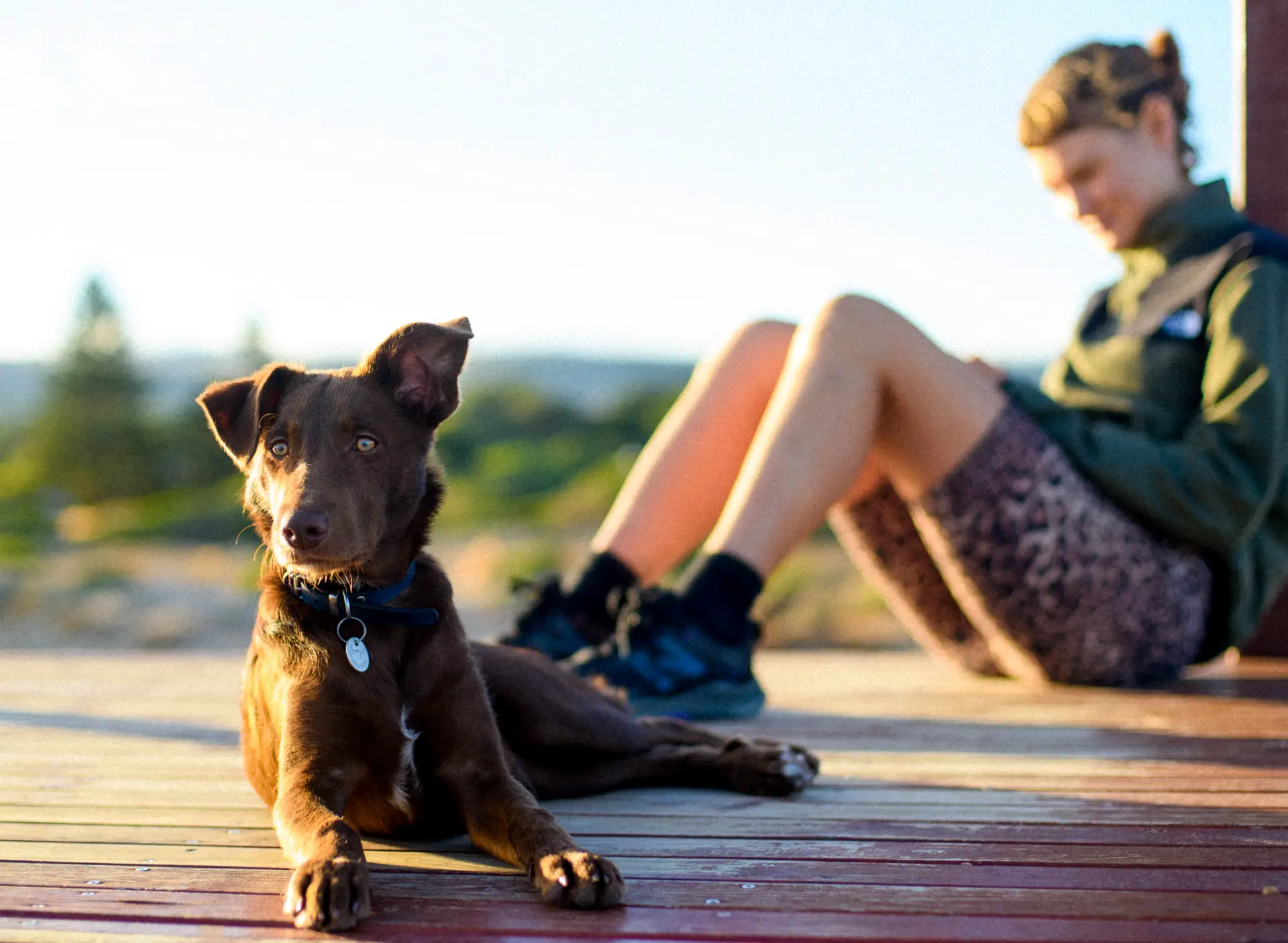
Okay then – how about that D700 I’ve owned since 2008 and which is still a workhorse round-the-house and people camera? The D700 is too big and heavy to carry with me. It is such a lump. I think it’s a really great camera and I love the IQ; I love that sensor, but yeah; the weight is a deal-breaker. Or maybe I should say the weight is the excuse I used to myself for buying a Nikon Df. I also really wanted to try the Df 16MP sensor. For me the 12/16MP sensors in the D3/D4 (and hence D700/Df) are sensors from the Golden Age. I just love what the D700 gives me. I’ve shot it in Raw from the start; the D700 .NEF files are only about 10MB. How about that? The Df’s are 16-20MB – which is still okay.
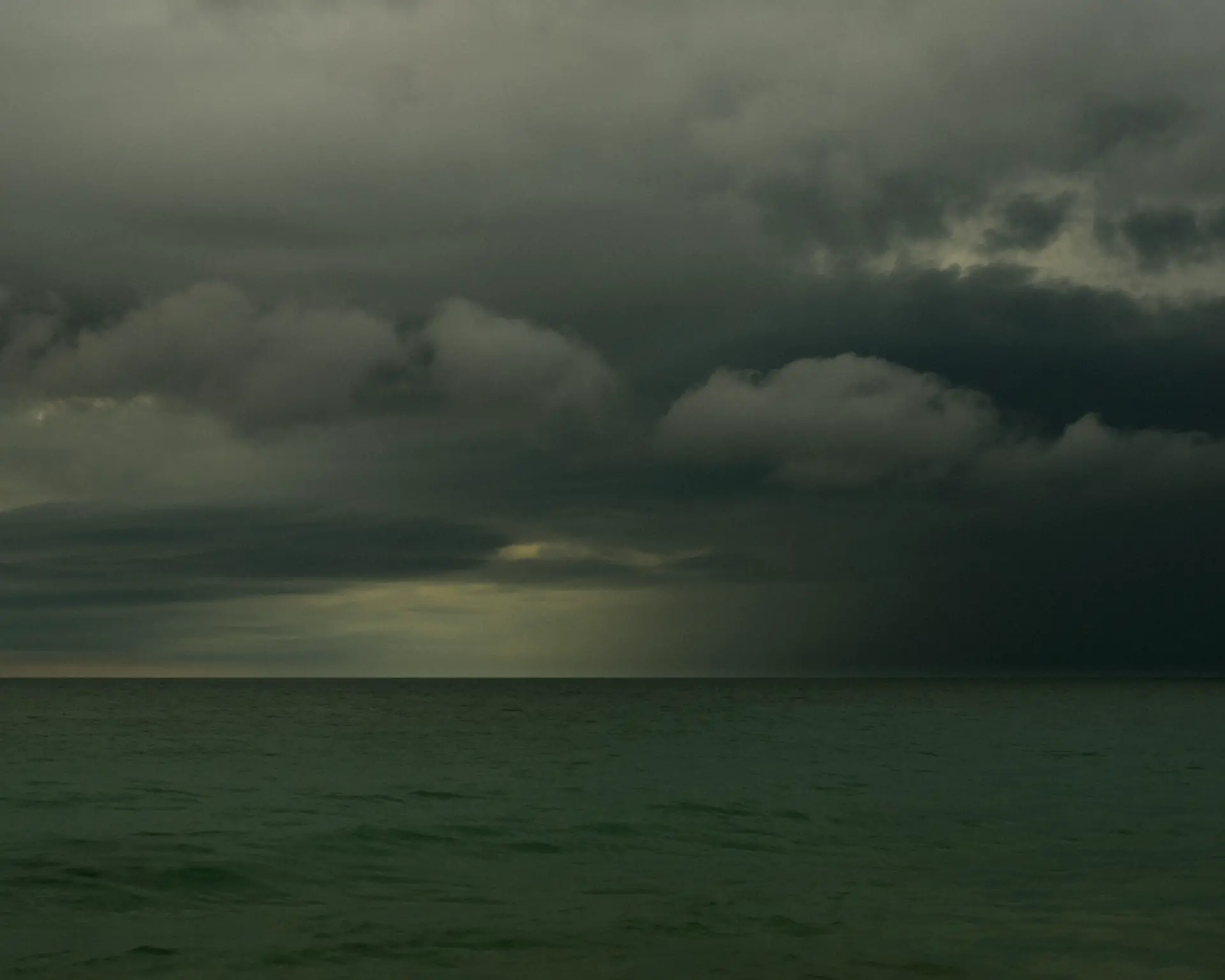
I have not yet really put the Nikon Df sensor through its paces… AFAIK it’s the last in-house one before Nikon went all Sony in their FF DSLRs. I don’t want to make too much of this though; the info on the net is a bit ambiguous and I don’t want to contribute to that net no-no of repeating rumours til they get traction and become accepted. I do think though, that if you’re working on ways of post-processing it’s best to stick with one sensor. I really don’t (currently) believe that you can have a LR preset that “works for all sensors” as many claim. I like the idea that I can now just work stuff out for the FF Nikons.
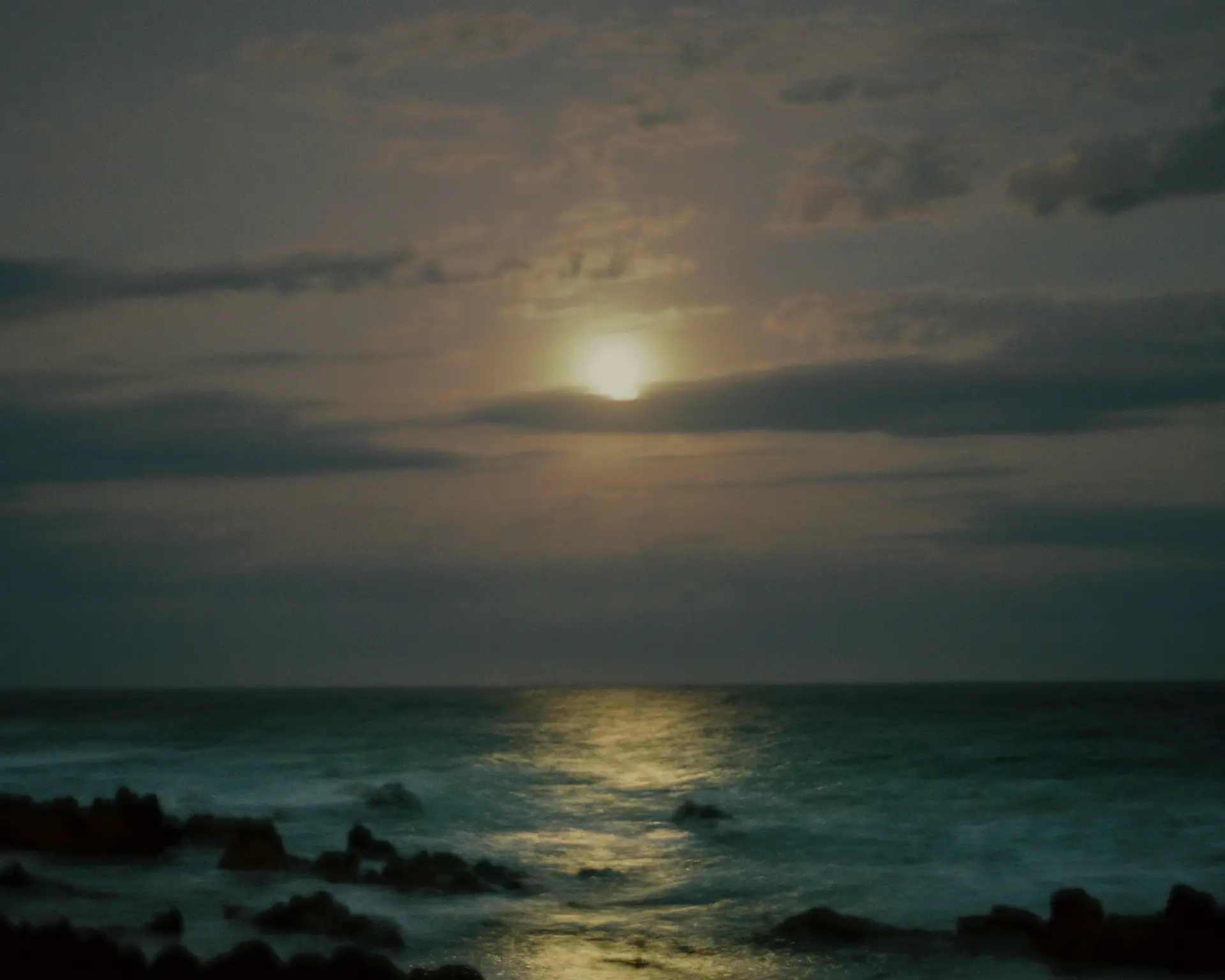
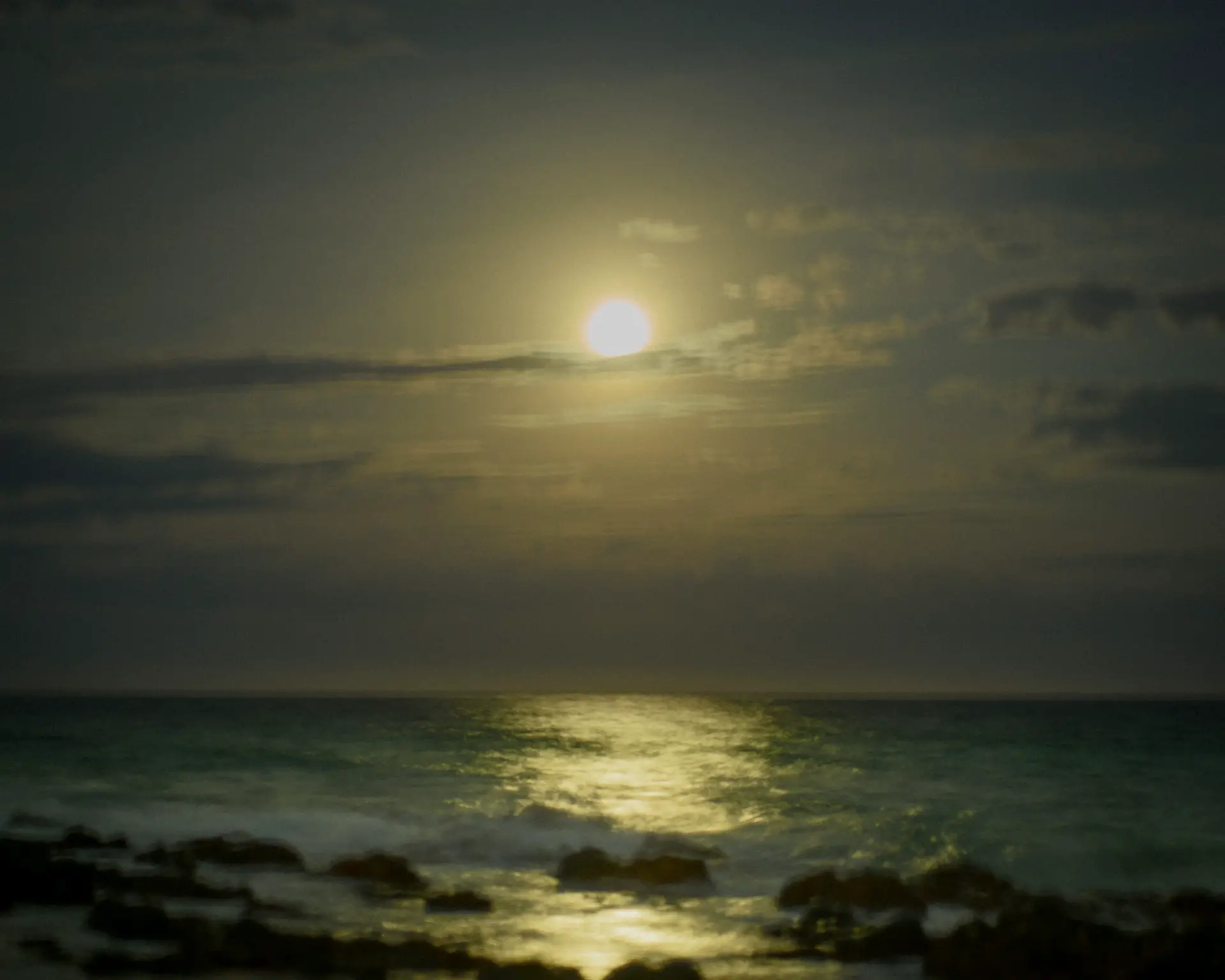
As an aside, I don’t know where this will send me in terms of Fuji-land. I’ve become such a Fuji fan-boy over the past ten years since starting with the original X100 then using an XE-2 for editorial travel work then moving to the X-Pro 3 for fun. I’ll have to say that another reason to try the Df was that I was not really getting what I wanted from my X-Pro 3 for landscapes recently. One reason for this is ISO. I believe you can’t simulate the look and use of film without shooting the same ISO. If you’re going to compare digital to Ektachrome 100 I think you have to shoot at 100. Portra 160 at 160 and so on. I can’t actually shoot my XP3 below 350 or thereabouts to use the Auto DR functions. Another thing is the lenses and the way the lenses play with the sensors. The Fujinon 27mm f2.8 on my XP3 was too bitey and clinically sharp. I wanted something more like my Nikkor 50s and putting a big 35 f1.4 on the XP3 makes it almost DSLR-sized.
The Nikkor 50s are my favourite lenses so why not get a body for them? This is probably a story for another day though – let’s just say I like the Nikon Df sensor and leave it at that. Looking behind the shutter and seeing that nice big sensor makes me happy.
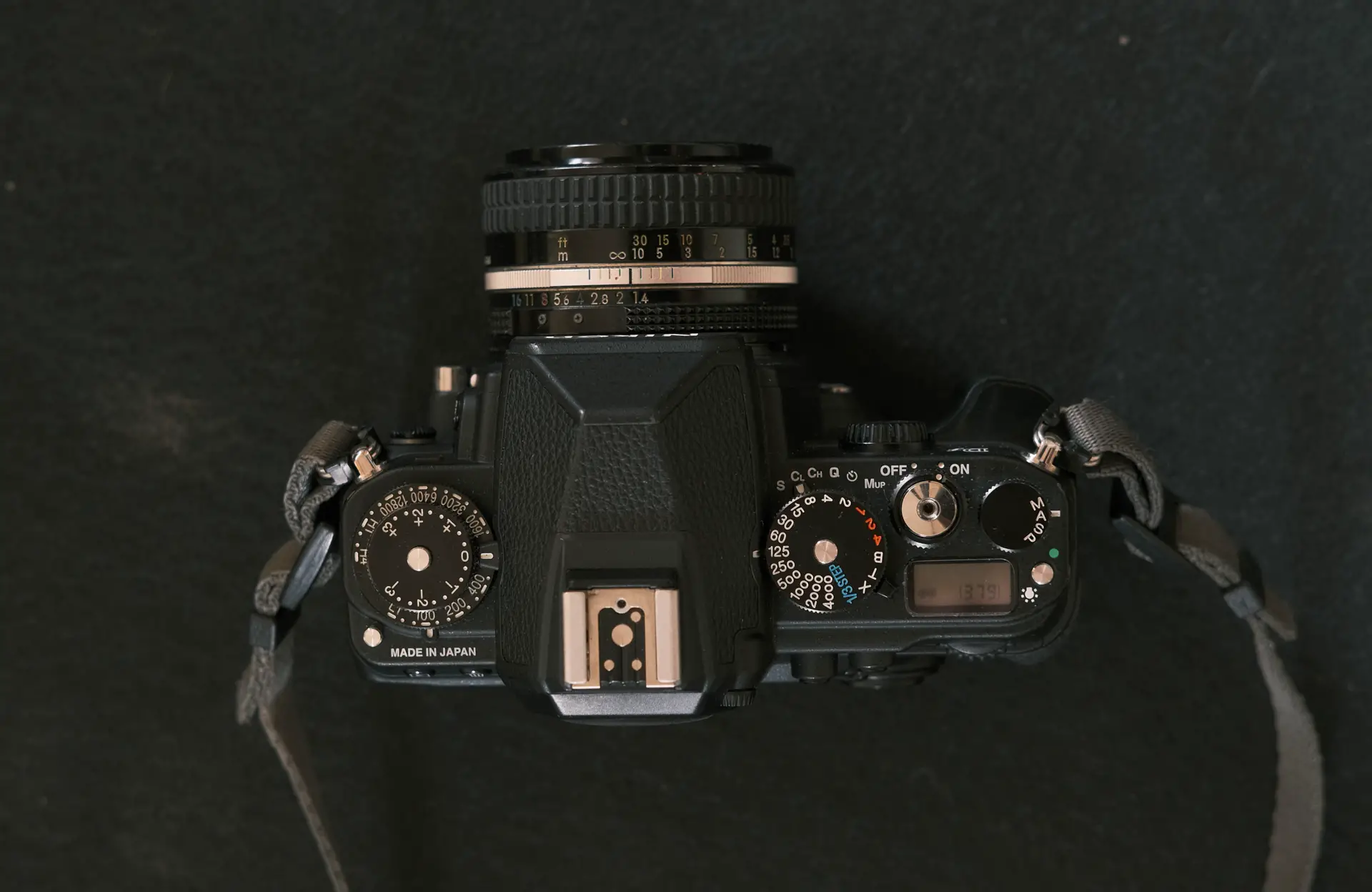
Time to talk about ergonomics.
In terms of the size and weight, the Nikon Df in the hand is not too different from a film SLR. It’s thicker than an FM or F2 of course, but it’s about the same weight as the F2 and it’s a lightweight if you compare it to an F4. The size/weight thing is really important for me, but it may not be for others. Two years ago I bought a little Billingham bag that is my travel bag. So what goes in that bag is my limit.
Some recent kits that fit this bag have been:
A: Fuji X-E2 with 27mm + Nikon FM2 with 50mm + Agfa Isolette 6×6 folder
B: Blad 503cx with 80mm + Fuji X-Pro 3 with 27mm
C: Nikon F2 with 50mm + Nikon Df with 50mm.
And I really could not take an F4 or a D700 with any other camera in that bag. So the Df works in that regard.
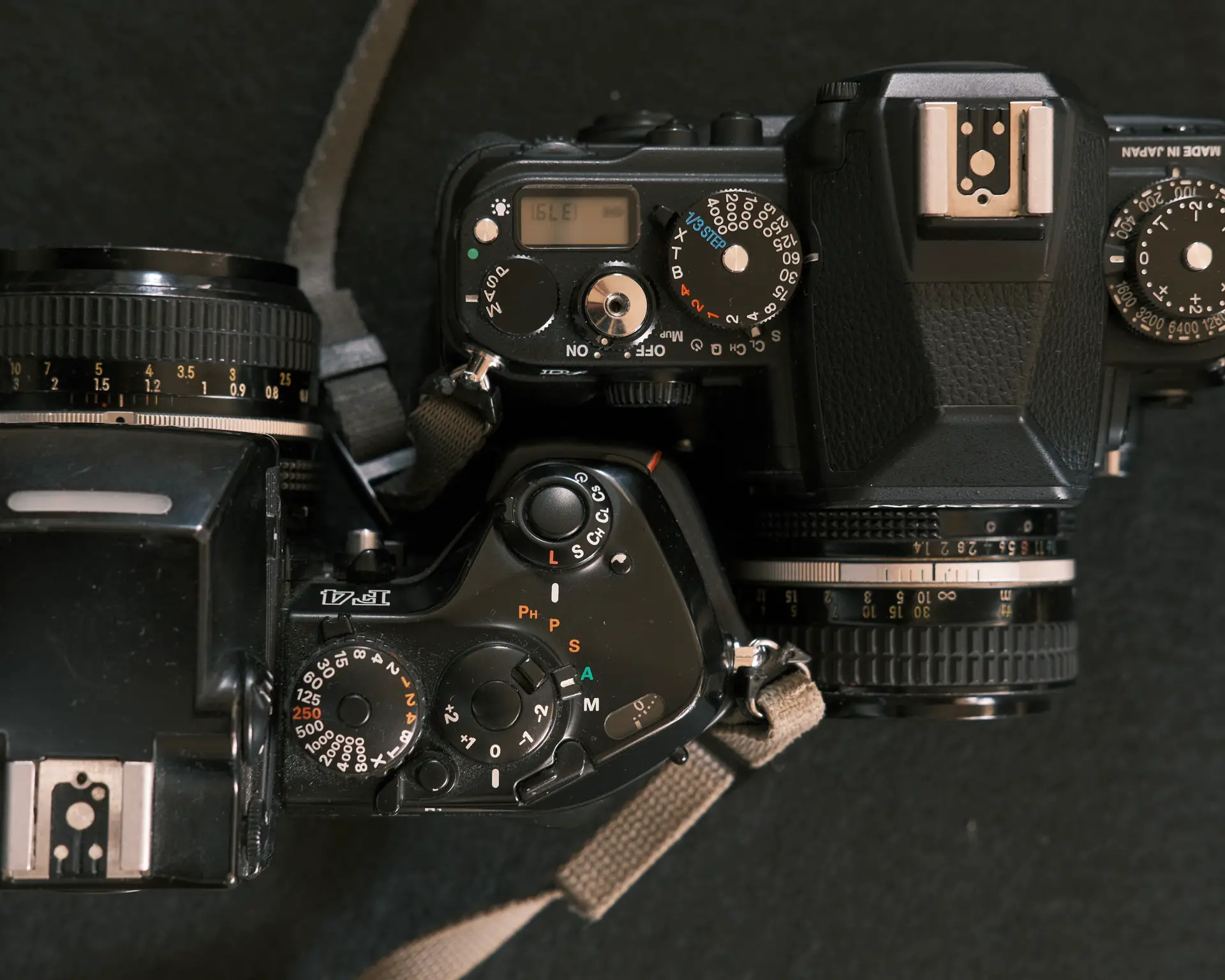
Shooting along side a 35mm SLR.
I’m currently shooting film alongside dig much of the time, and the controls and ergonomics of the Df actually make a lot of sense to me if you put the camera into an historical context. The Nikon film cameras of the time (F6, but let’s include F100 as well) were sort of like the DSLRs – control wheels and top LCDs. The Df is like a cross between that and an F4, but it also has similarities going back to the F2 and FM.
This is going to sound corny but it’s true: The first time I shot the Nikon Df alongside my F4 when I shot the Df I thought; “hey, that didn’t wind on,” before I remembered, “Oh yeah, no film.” The mirror and shutter is very F4; smooth and classy and I haven’t shot an F6 or F100 so I don’t know about them.
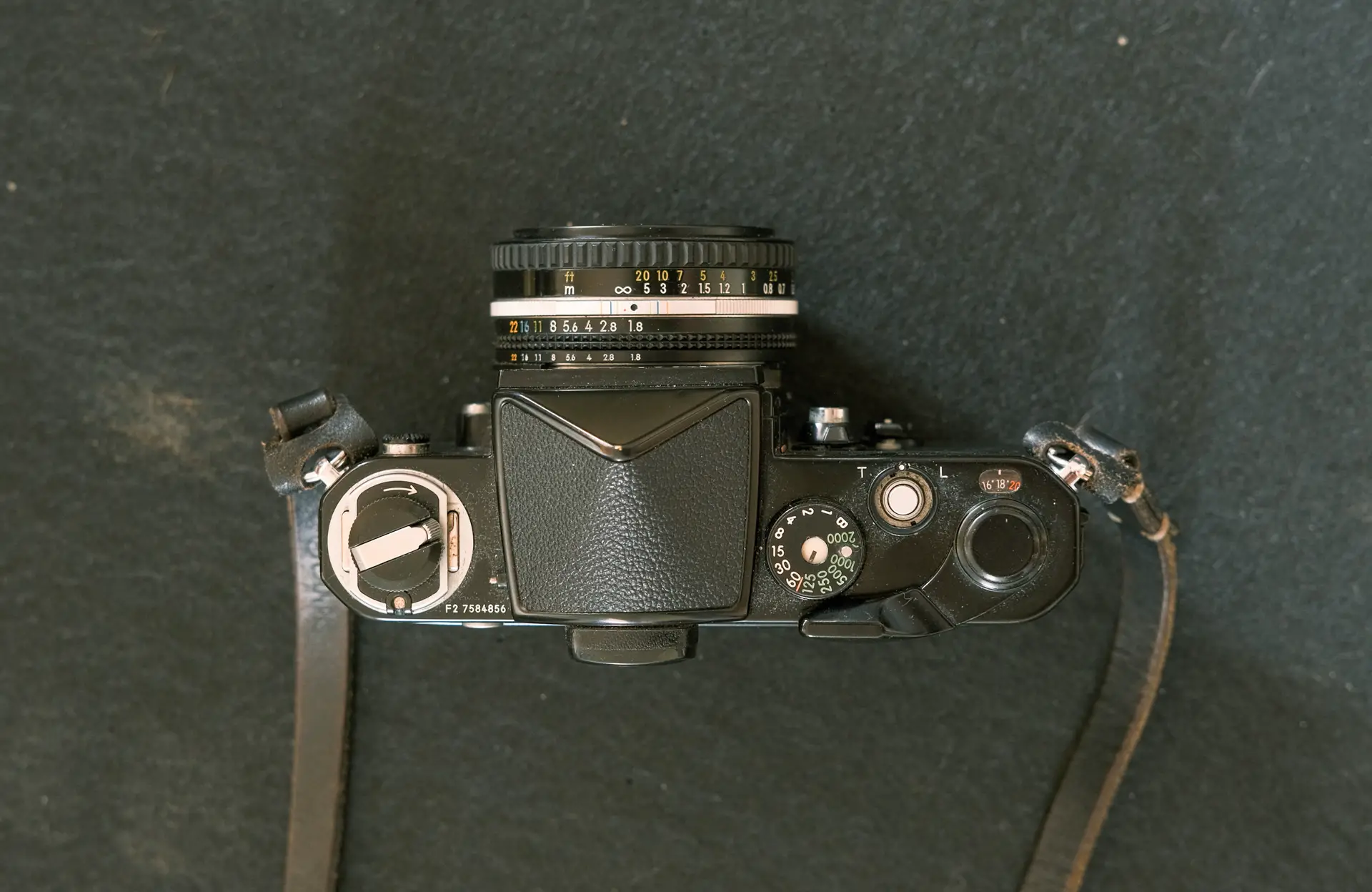
Controls
I’ll talk about just the specific bits of the controls as they affect me:
Shutter release and On-Off: Yeah I like it. The On-Off is like the lock ring on an F2 and the button is like an FM2. The half-press and the release are both good.
Stutter speed dial: Feels like an FM2 (but a bit rubbery in the bearing). Smoother than an FM and it’s a one-finger flick not a two-finger like the F2, F4 etc. (or you can set to a control wheel if you like).
Top LCD and the PASM dial: I’ll put these together because they’re both too small, but they need to be so they fit in. The LCD on the Nikon Df is actually handy because you can use it as a light-meter for your unmetered film camera which you are using because you’re too cool to have a metered one (coughs). If the PASM is on A, then giving a half-press will tell you the speed too use for the aperture you’re on. (assuming you’ve set your Df ISO to your film speed)
Metering: It meters the same as my F4 – tick. So while I will expose film and dig differently, at least I have a light meter I can trust. It’s one more safety feature and one less conversion to do in my head.
PASM dial: Sure it’s small and fiddly, but as a concept I actually like it. It got a pasting on reviews of the time, but if you’ve used an F4 you see that doing it this way actually makes sense. Personally I only ever use A or M though, so your mileage may vary.
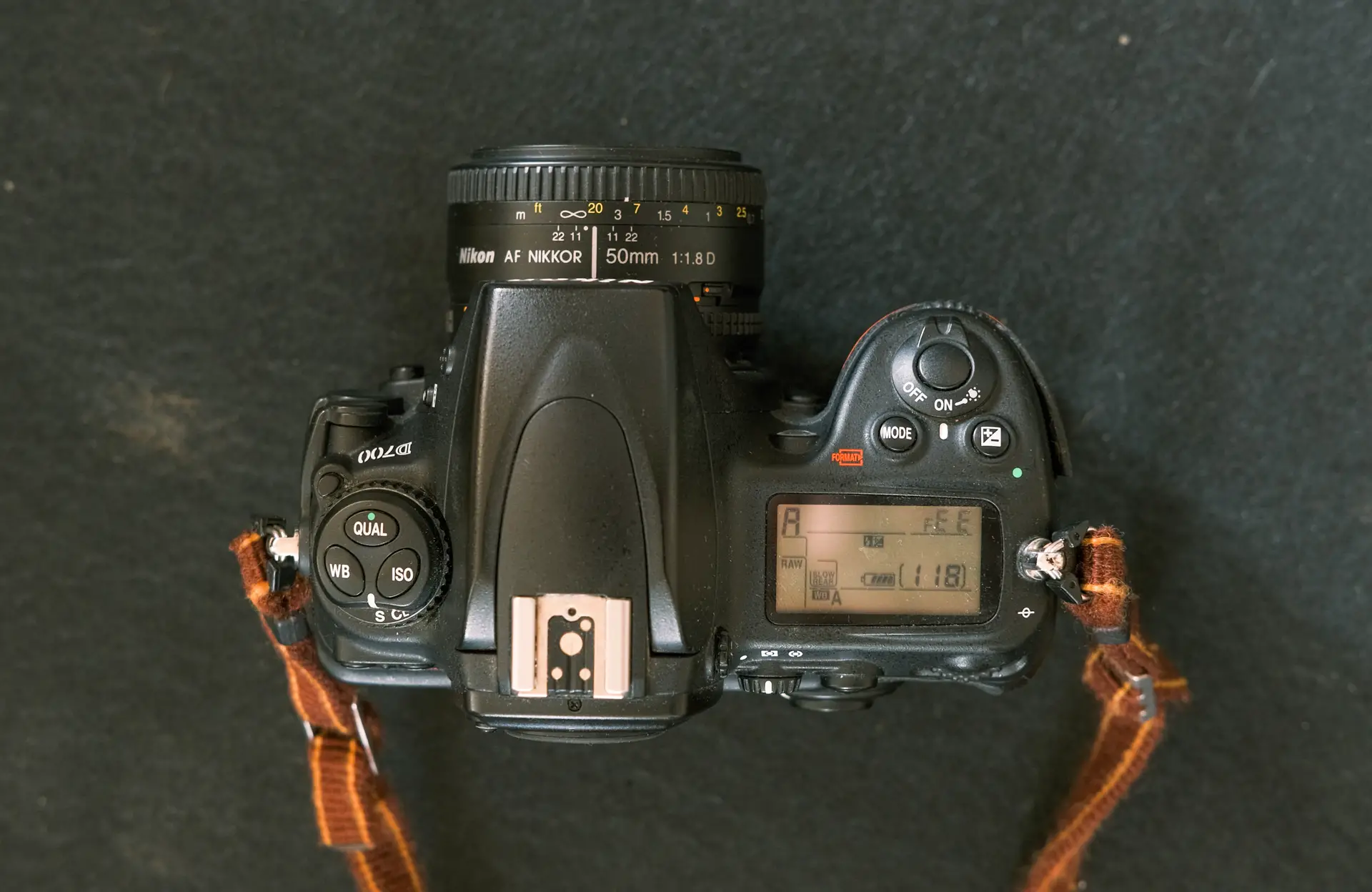
Focus/Back-focus button: Using AFD lenses on the Nikon Df is fine, works really well and makes sense to me. I probably would not bother with my zooms though. I don’t think the Df is for people who use zooms. I only ever used back focus on the D700, but on the Df the button is a bit close to the right because the body is smaller. No dramas – I’m used to half-press focus now, so I can use that if I want to. By the way, the AF is another thing that got a pasting at the time – because it was “only” from the D600 and had less points than the D4 but seriously who would care now? It’s fine and it’s nice using the multi-press button on the back of the camera to change the focus points.
Focussing Screen/Viewfinder: It’s smaller than an F2/FM etc, same size as an F4. It’s fine for AF and a bit small for MF and also does not have a split prism. This makes it not so good for MF lenses but I can see why they did this; If you had a prism it would be really strange with all those AF points. I’ve got a split prism on my F4 and yeah, it’s better than the Df for MF lenses, but seriously if I was going to use the Df for people shots I’d probably just buy a couple of AFD primes, which are cheap anyway, and leave it at that. For landscapes or wide angle lenses, bung on your old Ais lenses and all good to go. The viewfinder display is great – like a D700 etc. Easy to read, customisable.
Menus/rear screen: They’re like the D700. I like them, but then I’m used to them. I think any talk of doing without a screen and buttons (The mythic Digital FM – queue trumpets) does not really make sense. Or it certainly did not in 2013. I guess it would now with smartphone apps to change settings on the camera, but wait for a full-frame PIXII for that I reckon. (Don’t expect it from Nikon – just look at what Nikon did with the ZDX – yikes!)
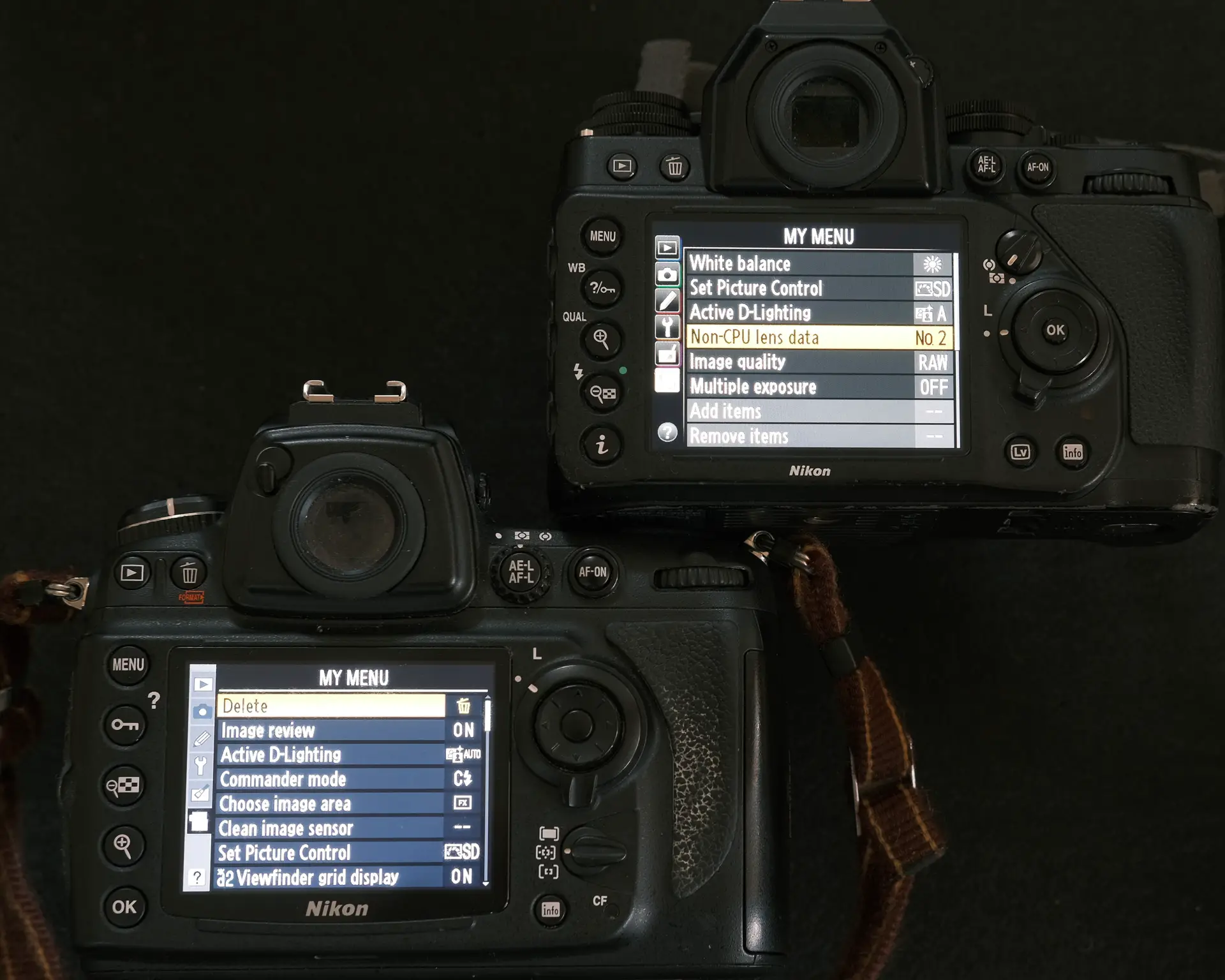
Side Grip: Yeah, it’s nice and the Nikon Df is secure in the hand with a one-handed grip. It’s all compromises though; more secure means a bigger grip more like the D700 et all. Flatter means more like the F2 but means you always need two hands.
ISO Dial and Exposure comp: Yeah; they work. I don’t use auto ISO any more so it’s nice to have a dial to change it. Another super thing is base ISO of 100. This means you can simulate shooting 100 ISO films. I can’t see myself using the exposure comp wheel much; I’d probably just change to spot metering if things were not straightforward, but that may change.
Battery/Door: This is about the only thing that annoys me; because with no WiFi you’re always opening it to get the card out, and it’s fiddly and plasticy and feels like you’ll break it if you’re not careful. So unlike the back of the F2 and the battery door of the F4 which are sweet every time you use them; the door of the Df says “cheap!” every time you use it.
OK – what’s the point of all this then?
Ah – to USE the camera I guess…
I don’t think anyone looks at a great photographer’s work and says, “Oh man – that film stock!” Or,” Wow – what a sensor! What a camera!” Sure, photographers have a style, but crushing the blacks in grainy B+W won’t make anyone into Anton Corbijn. I have the same type of tennis racquet that Federer used in 2001 to beat Sampras at Wimbledon but I can’t even feed a ball properly in a warm-up with it.
It’s something we need to get away from. So I guess I’m walking into a contradiction here; I’m buying a new camera to try to un-camera myself a bit. (In my defence I have now adopted a “one in – two out” rule for cameras and lenses to reduce the clutter, so my total camera numbers are down.)
I guess what it comes down to is that I wanted to simplify my film-dig shooting by removing variables. I now have the same image capture size, the same lenses, and a pretty similar shooting experience. Getting to this point meant I felt I should be using a Nikon DSLR alongside my Nikon film SLRs. The Df is the smallest, lightest FF Nikon, and the only one that is small enough for the way I like to shoot. So currently it’s the best camera for what I want. Is it a good camera? Sure. Do I like it? Jury’s still out on that one…
I love shooting film at the moment, but I don’t want to be reliant on it. A lot of this is also about learning. I think by interrogating the limits of what film can do and what dig can do I can learn to use both better; I can see both in a broader context. I’m getting better at training my eyes to evaluate a scene for how my camera will record it on both film and dig, and work out whether I’ll be able to get something I like out of that.
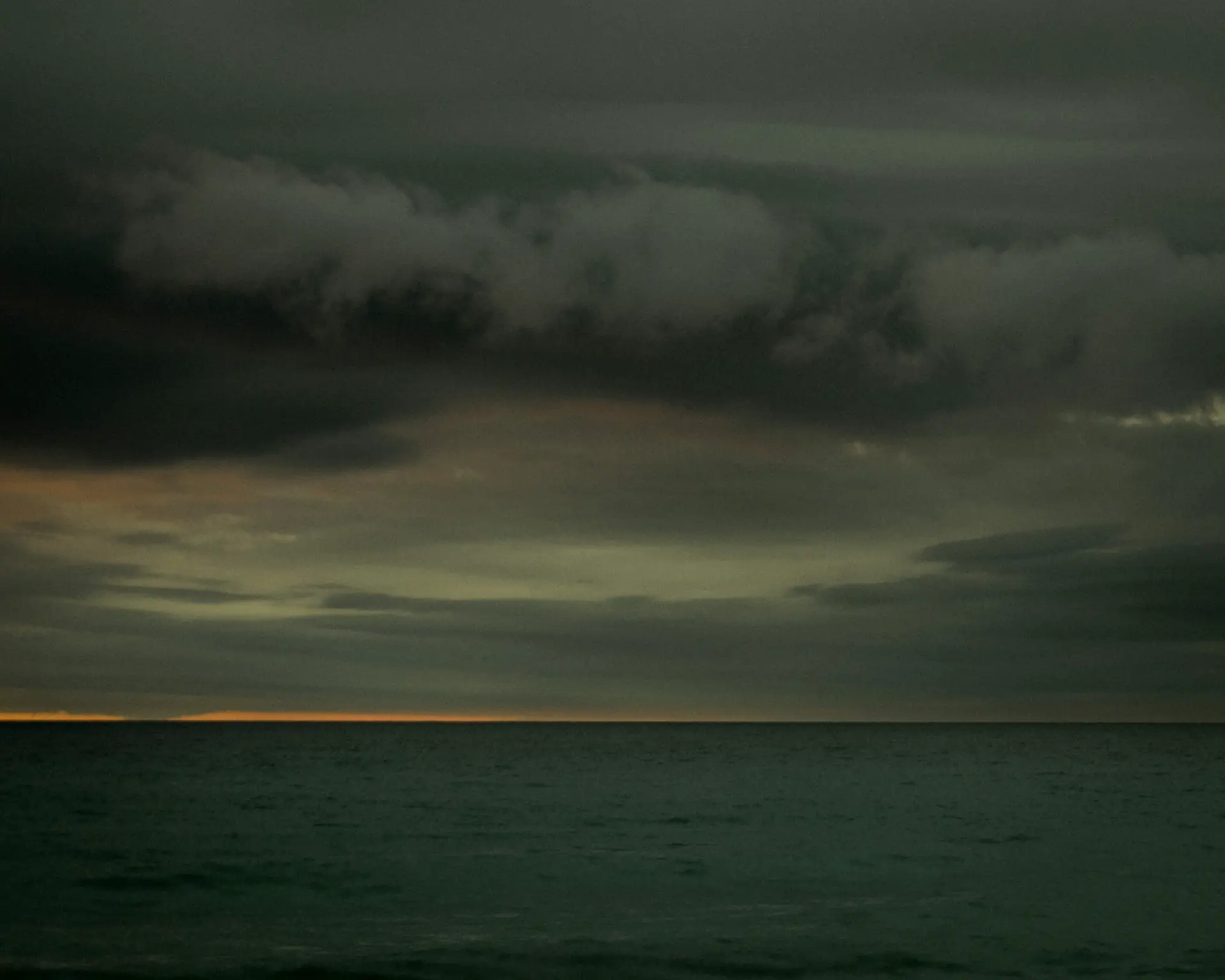
In the film days I used to be more evaluative of the light; spend more time looking at how the light was falling and forming the scene, and dig made me a bit sloppier in that regard; not so much with landscapes maybe, but certainly with people shots. I’ve recovered that care in my film photography, and I hope am also getting it back with digital. It’s actually pleasing to go out for an hour looking at landscape and not make a frame at all – film or digital – because the light was not quite right. With dig there’s always the temptation to bang off a shot anyway just in case.
I’m not purist in any way about either film or digital; I happily post-process both, and I’m not trying to make my dig shots into film shots. I’m trying, I think, just to learn from both, and just make shots I like.
Thanks for reading!
If you are looking for a manual for the DF, one can be found here
Share this post:
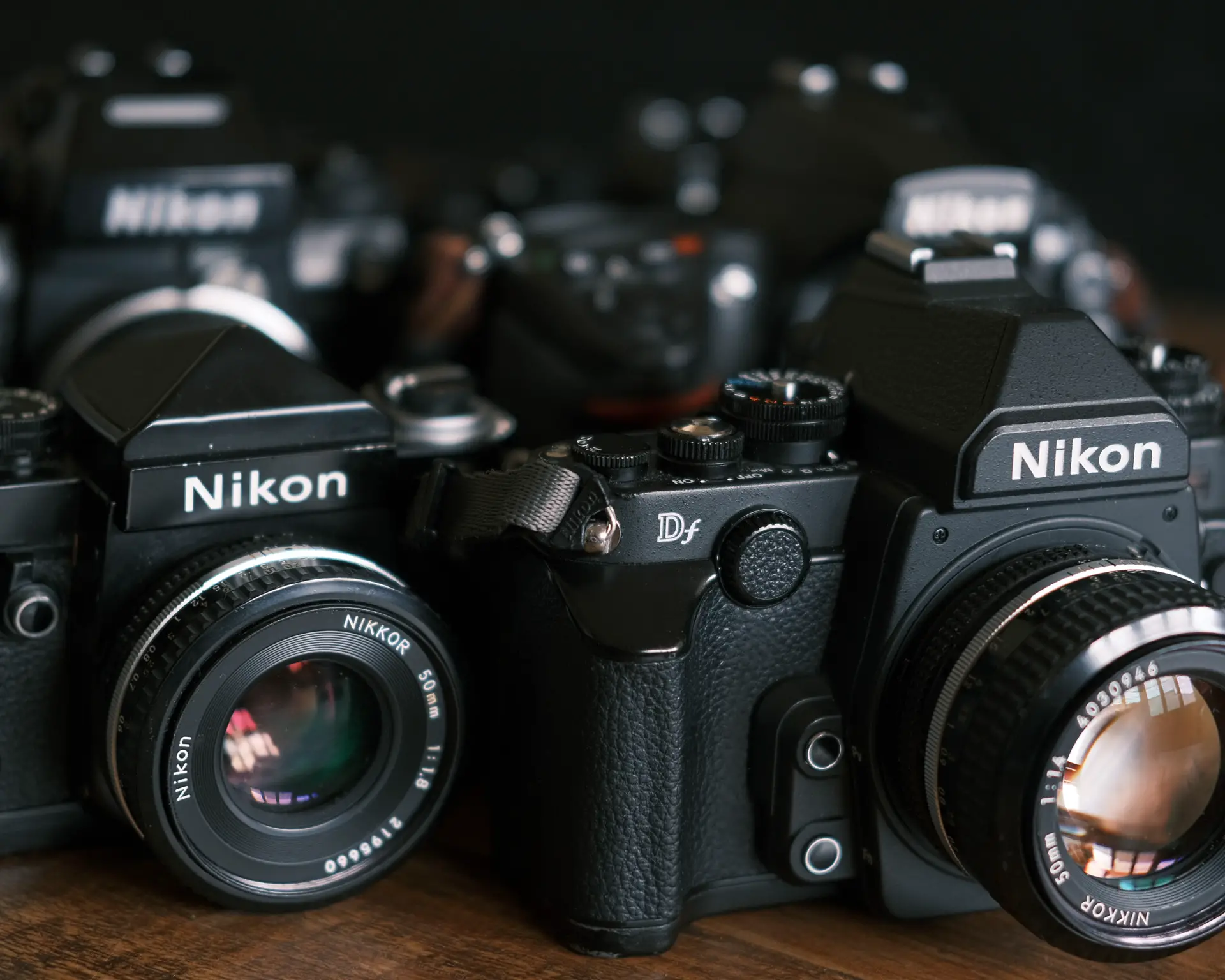








Comments
John Earnshaw on Nikon Df – Thoughts From a Film Shooter – by David Hume
Comment posted: 23/05/2022
Do I love the camera, yes I do and it blends in well with my Nikon film cameras. It is worth noting that here in the UK, prices for used Df's has skyrocketed in the last two years.
Comment posted: 23/05/2022
Jim Wolf on Nikon Df – Thoughts From a Film Shooter – by David Hume
Comment posted: 23/05/2022
Thanks again.
Comment posted: 23/05/2022
CP93 on Nikon Df – Thoughts From a Film Shooter – by David Hume
Comment posted: 23/05/2022
Comment posted: 23/05/2022
Pablo García on Nikon Df – Thoughts From a Film Shooter – by David Hume
Comment posted: 23/05/2022
Why do you say you can't shoot the Xpro3 above 350ISO?
Thanks!
Comment posted: 23/05/2022
Wouter Willemse on Nikon Df – Thoughts From a Film Shooter – by David Hume
Comment posted: 24/05/2022
But as implied, I never used the Df, instead opted for a D810 as replacement for the D700. Yes, it's heavy and large, and it produces large files. But as lovely as those old sensors are, those new ones deliver magnificent results too.
David Hume on Nikon Df – Thoughts From a Film Shooter – by David Hume
Comment posted: 24/05/2022
Comment posted: 24/05/2022
Lee on Nikon Df – Thoughts From a Film Shooter – by David Hume
Comment posted: 24/05/2022
But I did have to make some sacrifices. The X-H1 is a bit of a battery hog and, while the lovely battery grip adds loads more battery life, it defeats the purpose of having a more compact mirrorless system. The Fuji X-mount cameras are all APS-C, so my vintage wide angle lenses all become wide-normal focal lengths (28mm becomes 42mm). But I think I got much more than I gave up. I simply love focus peaking, the dual SD card slots, and the stabilized sensor for shooting vintage glass. If all I had were Nikon lenses, an option like the Df might be attractive for someone like me.
The Nikon Df sells on Ebay for between $800-1500, with the majority sold for more than $1200 USD. I bought my lightly used X-H1 in October 2020, with battery grip, 2 batteries, and accessory flash, for $900. The X-H1 has a 24MP sensor, excellent high-ISO performance, can take video in 4K/30 or 1080/60, IBIS, and it was released in 2018, a full 5 years after the Nikon Df. I think the X-H1, or any similar mirrorless digital camera, represents a much better value proposition than the Nikon Df. You don't even get a split prism focusing screen in the Df. I think that would be a deal breaker for me.
Comment posted: 24/05/2022
Alex Fry on Nikon Df – Thoughts From a Film Shooter – by David Hume
Comment posted: 25/05/2022
A huge part of what makes me want to pull out a "real" camera out, rather than just my iPhone, is the tactile experience of clicky controls and buttons.
Just this week I finally got around to swapping the focusing screen out for a K3 screen from https://www.focusingscreen.com/
Which has finally made the camera actually feel like what I always imagined it would before I got it.
Much easier to focus with my AI-S glass, partially becuase I finally have a proper split prism, but perhaps more so because doing the install finally forced me to fix what was aparently a viewfinder back focusing issue that had been there the entire time I've owned the camera.
Much happier with it now. (Just need to deal with a couple of bits of dust I introduced during the install).
Comment posted: 25/05/2022
Dave on Nikon Df – Thoughts From a Film Shooter – by David Hume
Comment posted: 25/05/2022
Comment posted: 25/05/2022
Jay Dann walker in MelbournE on Nikon Df – Thoughts From a Film Shooter – by David Hume
Comment posted: 28/05/2022
Instead I went with the Nikon I had previously decided after much research, would be best suited for me - the D800. This I've never regretted, my D800 is THE camera for my needs as a photographer.
Its ergonomics are entirely adequate - again, for me. The image files are eminently usable. I can put all my D prime lenses on all my Nikons - two D800s and two D700s, don't ask why, I would have to say "I don't know why," I'm not a pro, I just have them). A major reason for my decision was I can use my Nikon D lenses (nine primes, one ancient 28-85 zoom) on my digitals and my F65s. Digital and film, in one bag, often used together when I go out to "make good pictures" as the old Kodak amateur hand books once exclaimed.
Yes, the D700s and D800s are big. And I'm no longer young. So there is also a Fuji XT2 in a bag, with four superb Fujinon lenses, all together weighing less and taking up no more space than the Nikon gear I used to cart around in my travels. My partner also went Fuji, with an XE2 now being used with my Fuji 18/2.0 wide angle lens. It's all about, well, "evolving", isn't it??
Another advantage of the D800s was I paid less for the two than the cost of one Df, which in Australia still sells for big money. My 800s cost me $650 and $850 (secondhand of course), with <5000 actuations on one and an amazing 1<400 clicks on the other.
As an amateur, obviously my needs are different from those of the pros. This said, I've just this last week made a sale of a dozen color images to an architecture book publisher, my first since the seemingly so long ago pre-Covid times.
As the old saying goes, "horses for courses".
From Dann in Melbourne, Australia
Comment posted: 28/05/2022
Serhiy on Nikon Df – Thoughts From a Film Shooter – by David Hume
Comment posted: 29/05/2022
Comment posted: 29/05/2022
Jay Dann Walker in Melbourne on Nikon Df – Thoughts From a Film Shooter – by David Hume
Comment posted: 29/05/2022
As we get older (also a given, as after all none of us are getting any younger, ha!!) I think it's important to "think minimal" and opt for lesser gear. One camera, two lenses at most Three for special situations. Zooms are now too heavy for me, so other than an ancient 28-85 I lucked into at a garage sale in 2003, which has to be one of the sharpest zooms I've ever owned (Iand 've had heaps in my time), I go primes all the way. Mostly 28/2.8, now and then 35/2.0, occasionally 85/1.8. All Nikon Ds of course.
All this gear talk must not detract from the excellent points you made in your article - what I got from it was, while one camera or another camera may be ideal for this or that, in the long run (or even the short run) it all comes down to what is best for YOU. We all have to move on, beyond the (mostly manufacturer "influenced") online reviews or the celebrity blogs along the lines of "this lens (usually the latest in the line) is absolutely the best and the greatest for everything to interplanetary to macro" gushes. Learning what is best for us and how to intelligently and critically decide on those options that suit us against what the camera shops want us to buy, is crucial. In this sense 35mmc and your article sum it all up so well - a sensible appraisal of the Df , now no longer made but still cherished by so many, and an intelligent consideration of why this camera would suit a photographer in 2022,
I hope to see and read more of your writing in future. You are worth following. My compliments to you, mate.
From Dann in Melbourne, Australia
PS To appease any skeptics who read this, may I say that I have never met and do not personally know the author of this article and so have no vested interest in what I have written. He is perceptive and insightful writer and I rate him as such. Full stop!!
Comment posted: 29/05/2022
Greg L on Nikon Df – Thoughts From a Film Shooter – by David Hume
Comment posted: 31/05/2022
The Nikon Df and the Nikon F6.
Df - has the great D4 sensor. Has the old school dedicated dials layout that gives me the the same vibe as the Nikon FE and Nikon FM3a that i grew up with (and still use).
F6 - Nikon’s SLR masterpiece. Beautiful grip. Handles great. A viewfinder superior to any Nikon DSLR. A joy to use.
So with the above bodies i can bring along 3 or 4 small MF primes and I’m good to go. I still shoot slide film so I bring a few rolls of Fuji Provia 100F and Provia 400x that i bought a ton of 8 years ago and stashed in the freezer. I recently added some Kodak Ektachrome to the freezer too. I average about 6 rolls of film per year. I need to shoot more film than I currently do.
Both the the Df and F6 support Nikon’s iTTL modern flash so I can use my little SB-400 flash on both bodies too. Great for indoors and for outdoor fill flash.
The only autofocus lens I ever use is the excellent small 50mm 1.8 AF-D - just like yours. Also have that 50mm 1.8 AIS pancake lens.
And I still have the first DSLR I ever bought - the classic Nikon D700. Pro body, built like a tank, has the great D3 sensor. I don’t travel with it anymore but I still use it occasionally. Still produces wonderful images.
And yes there is something special about those D3 and D4 sensors.
I shoot manual focus Nikkors 99% of the time on all the above cameras. I enjoy shooting both film and digital. I grew up shooting film and it is fun to shoot a few rolls every year. As long as i can shoot a few rolls and get them developed and scanned in a lab I don’t think I ‘ll ever stop. I think film and digital are complimentary. It creates a good mindset to shoot both in my humble opinion. And it's fun.
So keep doing what your doing. I think it’s awesome to be able to do both with a lot of the same glass.
Happy shooting!
Cheers,
Greg
Comment posted: 31/05/2022
Marcel on Nikon Df – Thoughts From a Film Shooter – by David Hume
Comment posted: 03/07/2022
The Df is now out of production. Nikon is fully focussing on the Z mount. This will keep the lens factories going for a while as there was hardly any new exciting lens to be created for the F mount.
The Df is a fantastic camera. Manual lenses are perfect for the Df.
The old vintage lenses can be modified to even have fully metered control. Old glass is fantastic.
Enjoy the Df, it will grow on you.
Comment posted: 03/07/2022
Comment posted: 03/07/2022
Comment posted: 03/07/2022
Nathan on Nikon Df – Thoughts From a Film Shooter – by David Hume
Comment posted: 01/08/2022
The DF has always piqued my interest - still does as a thing of beauty! But since getting a Fuji X100F (I sold my Nikon F3 to get that.....weep!) I think I am pretty much sold on mirrorless now as a system, and I'm saving for a GFX 100s.
I work in fashion, and I have a Nikon D800 which has never let me down in terms of image quality - with my primes it produces jaw dropping images and ginormous prints. BUT, autofocus when shooting portraits is always the snag with any DSLR. There is simply not enough "focus area" in a DSLR frame where you can attain lock on eyes or faces if you want a composition that is anything other than fairly central. Yes, the massive D800 sensor allows for a lot of cropping - but then what's the point of the big sensor. Yes you can attain focus and recompose, but then you aren't guaranteed sharp focus....certainly if you're shooting with a longer lens on this body, which in and of itself is something you need to master.
My biggest gripe however with all DSLR's (albeit I've only ever used Nikon) is having to calibrate my lenses. I don't think I've EVER purchased a lens that didn't require fine tuning in the body, and then retuning probably at least once a year. They are almost always back focusing and whenever you take a shot that doesn't quite hit focus, you're always left wondering if it was YOU or the lens. All these focusing gripes add up to a fairly frustrating experience when time is precious.
Using my little Fuji, literally all of these issues disappear. No longer do I have to use an annoying and fiddly joystick if I want to shoot portraits - it just locks on to the nearest eye, irrespective of where the eye is in the frame, and bang! Done. The lens on the X100 is obviously fixed, but with all mirrorless bodies, calibrating lenses is no longer a problem. They all just work!
As you say, camera and lens choices all ultimately come down to personal choice and what you shoot. For still life stuff, landscapes and architecture my D800 is superb (apart from its weight I guess). It just niggles me a bit when I am working with people and "need" to get that shot.
Although I am not nostalgic about film necessarily, I am a full manual shooter. So if I have to jump through loops to do what should be basic tasks (like focusing!) then I do sometimes question why I am shooting digitally in the first place. The camera is a tool after all. The very best camera and lens combinations not only render beautiful images, they also get out of the way and don't hinder the process. I personally think Fuji are on the best track when it comes to a modern approach to photography. The old adage " Form follows function" is very apparent in Fuji if you are accustomed to shooting manually.
Comment posted: 01/08/2022
Matt on Nikon Df – Thoughts From a Film Shooter – by David Hume
Comment posted: 13/03/2023
thanks to your wise article and all the other comments on the Df here helped me a lot for the final decision in buying a nice used one in early 2023. With around 6k shutter count and 1.200 € and no signs of usage at all I think I made a good deal looking forward to shoot with. Yes it is quite expensive for a used model but for me, everything on this particular camera makes sense for my work. To share my considerations:
For shooting events professionally I came from the d700 (as you and others did) looking for something extra in terms of low light capability lens compatibility and wheight. And yes, shutter sound: when you shoot with d700 everyone knows exactly where you are ;)
In terms of IQ and preprocessing 16mp is for me the sweet spot. Even when you get paid for postprocessing I don't want to waste time waiting for huge files to load. So, for shooting digital, 16 MP is the best you can get in my opinion for those jobs.
The handling together with smaller primes is very nice, easy to carry around the whole day. The well designed "look" of the Df raise definitely less attention than its chunky brother the d4 or even the d700 with battery grip.
In the end, yes, the Df is kind of something for special purposes on one hand (which made it controversial), but on the other it's size and lens compatibility makes it something like the perfect in-between film and digital. I think there is a reason why barely used Dfs are hard to find on second hand market.
Maybe you and others made the same experience that there is something like a teaching effect by those dials: using an aperture ring or the iso dial brings the settings not only to your camera but into your tactile memory. Shooting mirrorless with Sony a7iii for my day job or Olympus for Travel I really appreciate this different experience.
So, as long as gear matters when it supports your goals I hope you enjoy working with that "tool" as much as I do. - Matt from Germany
Comment posted: 13/03/2023
Comment posted: 13/03/2023
Comment posted: 13/03/2023
Joachim Elz-Fianda on Nikon Df – Thoughts From a Film Shooter – by David Hume
Comment posted: 03/05/2023
I bought an used Df in autumn 2015 because, after using the D700 for some years, I sought for a small and light full-frame DSLR for travel, open air concerts and city shots. The Df was the only one that would fit in the place of my F90X in my compact shoulder bag. I have it in use for concert and low light photography up to now.
What made me a bit angry was that the shutter broke just 1 month after ending of the warranty period and that where I waited for an open air concert featuring Patti Smith and I had no reserve camera on this occasion. Not only I missed that opportunity - I had just picked up the foregroups - but the repair was about 400€. I used Nikon cameras since 1989 like the FA, the F-501, the F90x, the FM2, the F3, the D70s and the D700 and had never any trouble with the shutters on those.
Today, I use a Nikon 1V3 for travelling which is much more compact. But for low light, for concert events, the Df is really unbeatable up to now.
Just a remark about the battery cover - it has the tendency to get loose if opened and to disappear. So I had to buy a new one until I found the original again. The replacements were not cheap but I think they are made from metal, not plastics as you described it.
Comment posted: 03/05/2023
Ani on Nikon Df – Thoughts From a Film Shooter – by David Hume
Comment posted: 16/05/2023
The sensor is wonderful and the image quality is top notch in my opinion.
Thank you for sharing your experience with this gem of a camera, I always enjoy hearing honest reviews and experiences with this camera because so many were quick to dismiss it.
Comment posted: 16/05/2023
Mike W. on Nikon Df – Thoughts From a Film Shooter – by David Hume
Comment posted: 18/05/2023
Regarding zoom lenses, I recommend you try the maligned 43-86mm (AI version), really nice within its limitations. Just make sure it's not "wobbly" as some are. Another cheap and great lens (and overlooked) is the 35mm Nikkor-S, which was a favourite, as was the Nikkor-H 28mm.
I have a few bits to sell and was looking at another Leica-M lens, but your article has got me looking at a Df again! So maybe this time I'll get one. I agree re. the D700, I had one back along and it stayed around the house because of the size and weight, but I was always impressed by the pics I got from it.
Have you had the leatherette peel off your Df? I notice on a lot for sale the leatherette is wrinkly or peeling.
Cheers!
Comment posted: 18/05/2023
Boris Dinkoff on Nikon Df – Thoughts From a Film Shooter – by David Hume
Comment posted: 05/04/2024
Comment posted: 05/04/2024